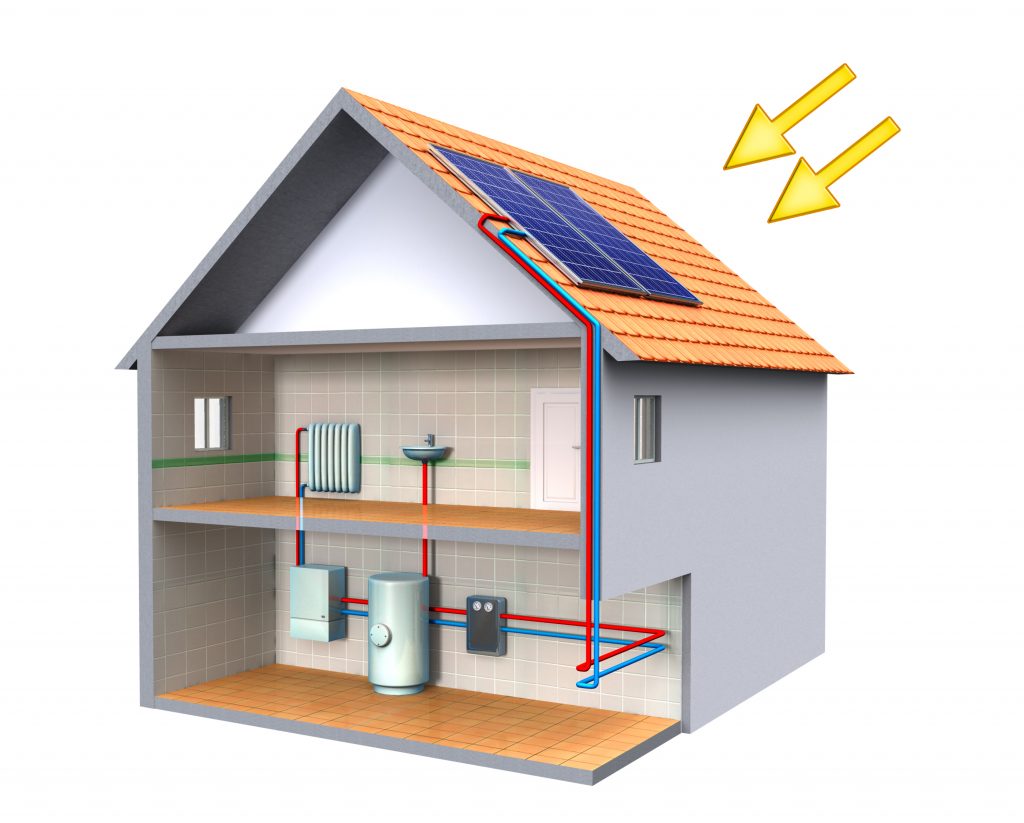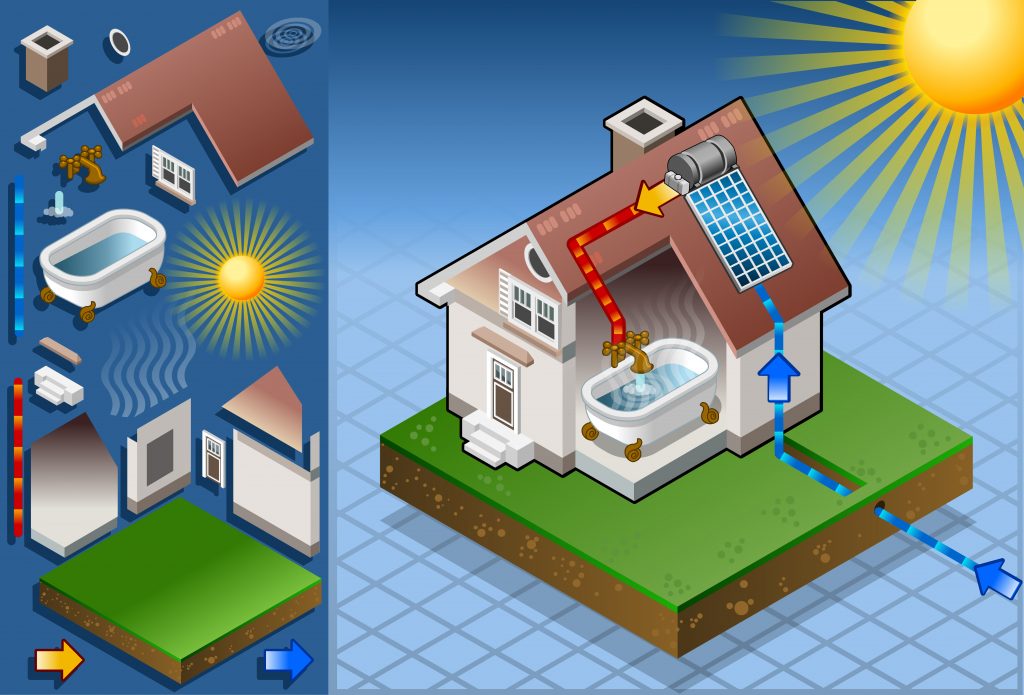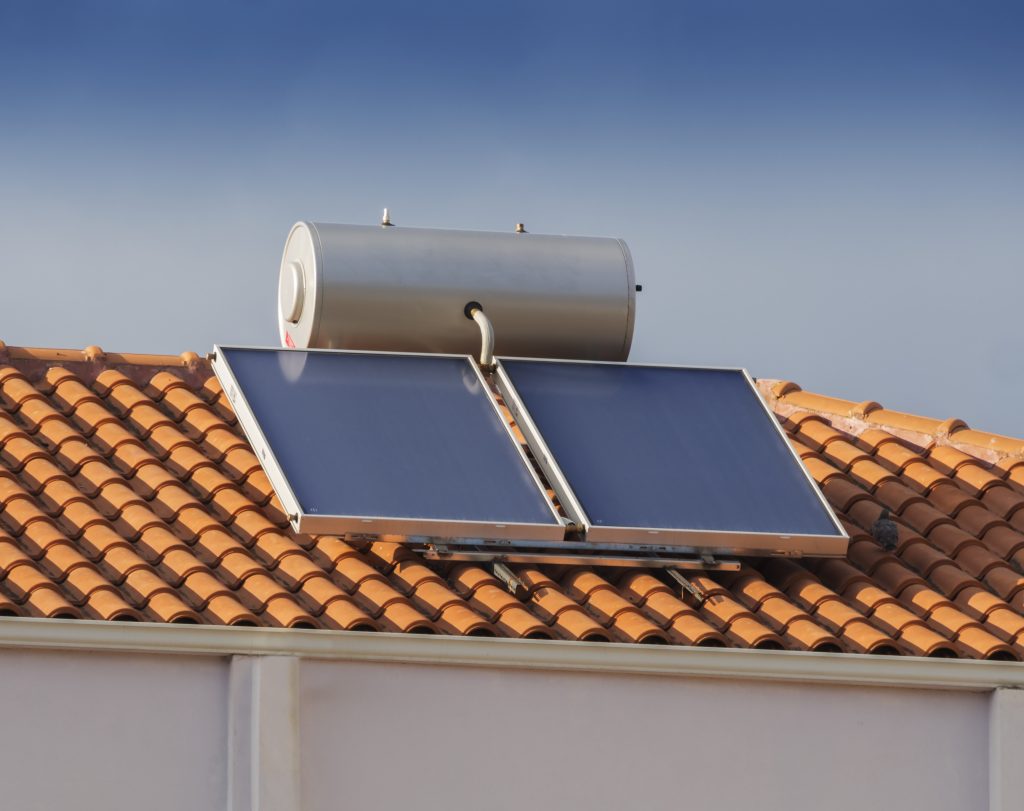Solar Powered Water Heater

Hot showers, running a load of laundry, washing dishes – we use hot water in our homes all the time. Heating up the water requires a lot of electricity, manifesting itself in increased electric bills. One novel solution that can help to avoid this problem is solar water heating- using the sun absorbed by your rooftop panel to warm up water at your home. Does it work?
What is a Solar Water Heater?
An alternative to conventional water heating, a solar water heater uses solar power, instead of the energy from the main grid to heat up water. They might seem a bit expensive to some (the prices start at $1000) but if the conditions are right, they might save you a lot of money on utility bills.
No matter what type, solar-powered water heaters almost always require a backup system (battery), to account for days when the sun doesn’t come out.
Why would you invest in solar for water heating? As the Department of Energy likes to point out, heating and cooling of your house make up nearly half of the total electric bill, so solar-heated water can be a relatively cheap alternative.
How Does a Solar Water Heater Work?
A solar water heater system contains “collectors” – parts somehow similar to panels that are typically installed on a rooftop. Unlike solar panels, instead of electricity, these collectors generate heat. These collectors come in different sizes and the type you install will determine the amount of water that will be heated.
The generated heat is turned into a “transfer fluid” and moved through a series of pipes known as a “heat exchanger,” to your water supply until it’s hot enough to be used at your home. Most solar hot water heaters also have a controller that regulates the water temperature to ensure it doesn’t get too hot or doesn’t stay cold, when when the outside temperate moves below zero.
Lastly, solar power heating systems should have a backup, to account for extensive periods with no sunshine. In fact, 20% of the hot water you use at home will come from the backup while the solar water heater will cover approximately 80%.

Active Solar Water Heating Systems
The transfer fluid in your solar heating system is moved around either by a controller pump or with gravity. Controller pumps are only used in active solar hot water installations. If your solar heating system relies on gravity to move fluid and water around, you have a passive system.
Why are we telling you this? While passive solar power water heaters are easier to install, they are also much less efficient than active systems, so you’ll have to weigh that into your decision-making. That’s why the majority of U.S. households use an active system for hot water solar heating.
Active solar power heaters can be broken down further into two categories.
Direct Circulation Systems
This type of system is predominant in warmer climates, since it pumps the liquid from the collectors straight into your home, skipping the heat exchanger.
Indirect Circulation Systems
The heat-transfer fluid is pumped from the collectors to the heat exchanger in a closed-loop system to heat up before it ends up in your home. Some heat loss occurs while the transfer fluid circulates the system.
Passive Solar Water Heating Systems
Passive solar heaters are usually less expensive, but also less efficient. Instead of a controller pump, they work on the principle of gravity – cold water has higher gravity than warm water, and so being heavier, it sinks down while hot water rises, circulating the liquid. That’s why the storage tank of the passive system needs to be installed higher up to work, putting pressure on your roof.
Thermosyphon Systems
Thermosyphon systems are a more expensive and reliable alternative to integral collector storage systems. The way they work is that as water flows through the system, warm water rises as cooler water sinks. The storage tanks must be installed on the roof with a lot of care, increasing the price of the total product.
Integral Collector-Storage Passive Systems
If you live in an area where the temperature rarely falls below freezing, an integral collector-storage system might be a good option. These systems contain large storage tanks with direct exposure to the sun. When the sunlight heats the water, it then flows directly through your plumbing systems into the taps in your home.
Storage Tanks and Solar Collectors
Since solar heating systems depend on the fickle nature of weather, a storage tank is an integral part to ensure that your household has enough hot water, even during extensive cloudy periods. A backup system may also be part of the solar collector, for example, a rooftop tank with thermosyphon (gravity-powered) systems.
There are three common types of solar collectors in solar-powered heating:
Integral Collector-Storage Systems
Sometimes also called a batch system, due to multiple insulated boxes containing tanks. The solar collector preheats the water and sends it on its way to a conventional backup system, where it’s stored until you are ready to use it. The downside is that since the tubes are placed outside your house, they can freeze so you should only install integral collector storage if you live in mild climates.
Flat-Plate Collector
Perhaps the most common type, flat-plate collectors contain a dark absorber plate that soaks up all the energy from the sun and then keeps it isolated in a weather-proof box.
Evacuated-Tube Solar Collectors
This type of collector contains glass tubes, placed in parallel next to each other and connected to a header pipe where the heat transfer fluid circulates to absorb the heat from the pipes. One great benefit is that the angle of the sunlight is always perpendicular to the tubes, so the system performs efficiently even when the sun is low, for example in the winter or a late afternoon.
Installing and Maintaining the System
So after you finally decide that solar power for heating water is a good idea, the next question will be -how do I install a solar water heating system at my house?
There are few things to consider- Does your house get good exposure to sun rays, do you live in a climate with extreme temperature, and does your building code contain any requirements preventing you from installing a solar water heater? Next, find a reliable contractor, with experience in installing solar water heaters – do your online research and ask for referrals also.
Finally, the amount of required maintenance will depend on the type of system you get. Passive systems don’t require much maintenance as they run on a natural process. However, heating water with solar power using an active system is a different story – you might want to confirm the maintenance requirements with your contractor.
To stay on the safe side, the overall system will require a routine inspection (every 3-5 years) and the electrical components will need replacing approximately every 10 years.

Improving Energy Efficiency
Once your solar water heater is up and running, there are additional measures you can take to further reduce your electricity usage and with it, your bill. Water heating makes up 18% of your total electricity usage, which makes it the second-largest energy expense in your home after your HVAC system.
One way to reduce hot water use is by repairing leaks in faucets and showerheads, saving you to $35 per year. You could also try to reduce the amount of hot water you use overall. The water you spend on showering and washing your hair is nothing compared to the amount used by your dishwasher and a washing machine. Invest in efficient, ENERGY STAR® labeled appliances instead – it will save you a few coins down the road.
Choosing a Solar Water Heater
Which solar water heating system to choose? The options are vast – water heaters come in different shapes, sizes, and functionalities, with or without a storage tank, with or without a backup. Make sure that you are matching the solar water heating system to your needs and not the other way around.
 | Extreme temperatures - If you live in areas where the temperature drops below 0 degrees, go for indirect solar hot water systems, that are built to resist severe weather conditions. Anything else and the pipes on the outside will freeze and likely burst. |
 | Time of day - If you like to use water all day round, opt for a passive water heater system, as it will produce hot water in batches consistently throughout the day. |
 | Sun exposure - Water heating with solar panels requires sun, so select your system based on how much sunlight your household receives. You might not know this but the direction your roof faces is quite important in determining how much electricity will your panels produce. |
In addition, look out for the following…
Capacity of the System
If you decided to use solar panels for water heating, you have to accept the risk that you might find yourself without hot water in some instances (a particularly cloudy week). However, you can mitigate this risk by estimating the average water usage of your household and matching it with the capacity of the system you choose. If you consume 500 gallons of water per day, get a storage tank that can support that.
Durability
Since solar water heating systems are installed outside, they have to be made durable to withstand different seasons and temperatures. Don’t skimp on quality materials to save a few bucks, because you will end up replacing the parts regularly, costing you more.
Ease of Use
Get your contractor to walk you through using and maintaining your water heater. Ask for tips and things to avoid. All this will help you avoid any problems after making the purchase.
Other Water Heater Options
If using a solar water heater isn’t the right option for you (either because your roof doesn’t get much sun or you aren’t willing to make the investment) below are other options for heating water in your household, each with some upsides and downsides.
Heat Pump Water Heaters
Heat pump water heaters work like a reverse refrigerator – they use electricity to move heat from one place to another instead of generating heat directly. They don’t cope well with freezing temperature, so you should opt for a heat pump heater only if you live in a location that remains in the 40º–90ºF (4.4º–32.2ºC).
They should be installed in a space with excess heat, such as a furnace room as they tend to cool down the surrounding air. Their biggest selling point is their energy efficiency (two to three times that of conventional heaters) and flexibility (a heat pump can be installed as a stand-alone water heating system or retrofitted to work with an existing conventional system).
Conventional Storage
Conventional storage water heaters remain the most popular type of water heating system in American households. They contain a backup tank — capable to store between 20 and 80 gallons in a single house unit– of hot water.
When you turn the tap, the hot water from the top of the tank is released while cold water enters the bottom of the tank, continuously filling it up. Some energy gets wasted as the water is stored in the tank, producing standby energy losses – you can avoid this problem with a tankless water heater.
Tankless Water Heaters
Also known as demand-type or instantaneous water heaters, this type heats up water directly, without using a storage tank. When you turn on the hot water tap, the water travels through the pipes where it’s heated by a gas burner or an electric element.
The main advantages of tankless heaters are that they deliver hot water instantaneously when needed and don’t produce any standby energy losses from storage. The downside is that they are relatively expensive to install, compared to the conventional systems.
FAQs
Are solar water heaters worth it?
According to the U.S. Department of Energy, solar water heaters reduce utility bills by 50 – 80% on average. That sounds like a great deal but don’t take it at a face value. Solar heater systems will require a substantial initial investment (prices start at $1000) and your payback period will vary based on many criteria – how much sun do you get, what type of solar water heater you buy, and your usage (the more water you and your family use, the more will your savings be when using a solar panel for water heating).
How many solar panels do I need to run a hot water heater?
Since water heaters are fairly inefficient appliances, one solar panel would be sufficient to cover your hot water needs throughout the day. If you want to be certain, use this simple calculator to determine how much hot water will your solar panels produce.
Do solar water heaters work in winter?
Some types of solar water heating systems don’t do too well in cold temperatures. For example, Integral Collector-Storage Systems have tubes placed outside your home, making them susceptible to freezing. Overall, solar water heaters won’t generate as much hot water in the winter. However, solar hot water systems are not made to replace your conventional water heater fully – the majority of U.S. water heaters will be connected to a backup, to ensure you can use hot water in the winter.
Are solar hot water systems worth it? Initially, they might appear as an expensive luxury and they certainly aren’t for everyone. However, in the long run, heating water with solar panels can help you save a lot of money, especially if you already own solar panels and get a good quantity of sunlight.
Using your solar panels for heating water will also reduce your dependence on the main power grid and make you less vulnerable to power outages and disruptions. Ultimately, solar hot water systems can help you lead a cleaner, greener life – and for once not feel too guilty when drawing a long hot bath.
Updated on



